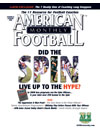AMERICAN FOOTBALL MONTHLY THE #1 RESOURCE FOR FOOTBALL COACHES
Article CategoriesAFM Magazine
|
Time for TurfSynthetic turf is replacing grass across America as the surface of choice for football programs from high school to the NFL.© More from this issue The trend may be irreversible. Each year, hundreds of football practice and game fields are converted from natural grass to synthetic turf. That’s not surprising, considering that today’s turf systems provide safe, consistent, all-weather playing surfaces that can be utilized 24/7 by not just the football team but by a long list of other sports and activities. ¶ Rick Doyle, President of the industry support group Synthetic Turf Council (STC), recalled a remark made by a board member at a recent meeting. “He commented that there were a total of eight ‘third generation’ infilled synthetic turf sports fields in the U.S. in 1997,” said Doyle, “and today, the estimate is 3,000-3,500.” According to the STC, the number of new turf installations, which is currently estimated at 650-800 per year, is expected to increase 10-20% each year ove....The full article can only be seen by subscribers. Subscribe today!
|
|
|||||||
| HOME |
MAGAZINE |
SUBSCRIBE | ONLINE COLUMNISTS | COACHING VIDEOS |
Copyright 2025, AmericanFootballMonthly.com
All Rights Reserved





